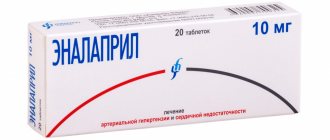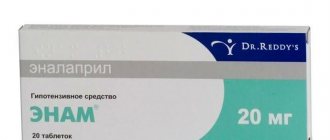Blood Pressure Tablets: Part I
High blood pressure is one of the most common health problems in Russia. This disease is especially common in older people who have to “take pills” to feel good and relieve stress on the heart. What is blood pressure, why does it rise too much, how diuretic medications help normalize it and how to take them correctly - read about all this in our article.
What is blood pressure
When the heart muscle contracts, it forcefully pushes out a large volume of blood, putting pressure on the walls of the blood vessels. Depending on the location, this pressure is called arterial (BP), venous and capillary. Pushing a fluid as thick as blood through 100 billion capillaries is no easy task. Due to the natural resistance of this complex network of microscopic vessels, the blood pressure “at the entrance” to the heart is much lower than “at the exit” from it.
The blood pressure “at the exit” of blood from the heart (that is, at the moment of its contraction) is called systolic, and the blood pressure “at the entrance” to the heart at the moment of its relaxation is called diastolic.
The average norm for an adult is considered to be 120/80 mm. rt. Art.; The first number in this case means systolic blood pressure, and the second number means diastolic. Thus, normally, the resistance of the capillary network “eats” 34% of the initial “power” of the blood flow.
In practice, the ratio of the two blood pressure readings varies greatly among different people and even within the same person at different points in time. It depends on a number of factors: heart rate, condition of blood vessels, elasticity of their walls (this parameter is skillfully regulated by the brain), etc.
Why is blood pressure rising?
Arterial hypertension (AH), also known as hypertension, is one of the most common diseases in the world. According to the latest WHO data, about 1.13 billion people worldwide suffer from high blood pressure. Blood pressure readings of 140/90 mm are considered elevated. rt. Art. and higher at rest.
The most common symptoms of a hypertensive crisis (a sharp increase in blood pressure in patients with hypertension) are headache, shortness of breath, chest pain and fatigue. Some patients experience dizziness, hear ringing in the ears, or notice redness on the face and chest.
The main cause of hypertension is excessive activity of the renin-angiotensin system (RAS). It is a cascade of chemical reactions that occur in the body in response to a decrease in blood pressure: the enzyme renin contained in the kidneys is converted into the enzyme angiotensin I, and then into angiotensin II. The latter is a powerful vasoconstrictor. The narrower the vessels, the higher the pressure. Angiotensin II also reduces the excretion of sodium and water by the kidneys. The more water in the tissues of the vessels, the smaller their diameter, which means the higher the pressure.
Arterial hypertension is also associated with an excess of calcium in the cells of blood vessels, as well as with an increased concentration of sodium in the vessels and in the blood. Many people know that calcium is good for bones and teeth, but not everyone realizes how important it is for the body as a whole. In fact, calcium is necessary for the transmission of nerve impulses, muscle contraction, blood clotting, the immune response, and so on. Without this metal we would not be able to think, move, or even live.
But in the body, as in life, everything is good in moderation. Calcium overload in vascular cells leads to hypertrophy of their muscle tissue. And this, in turn, means a thickening of the vessel wall and a decrease in its lumen. The “tube” becomes narrower, and, as a result, the pressure on its walls increases.
Why does calcium overload occur? Calcium metabolism in the body is regulated by hormones, and their level, in turn, depends on the concentration of other important substances. Thus, risk factors for hypertension are: obesity, sedentary lifestyle and hyperlipidemia (fat concentration), diabetes, smoking and alcoholism. In addition, old age is a key risk factor.
In the case of sodium, the risk factor is the abuse of salty foods and hormonal disorders that slow down the removal of this element from tissues. Sodium can accumulate in the blood, increasing its volume by binding water molecules. The more blood passes through the vessels per unit time, the greater the pressure on the walls of the vessels. In addition, the accumulation of sodium in the endothelium (a thin layer of cells lining the inside of blood vessels) leads to its swelling (essentially, edema) and, as a consequence, to a narrowing of the lumen of the vessel.
How do diuretics work?
In this article, we will look at only one class of drugs that are used to treat hypertension - diuretics. These medications are designed to “correct the situation” with sodium, while calcium metabolism and the functioning of the RAS are corrected by other drugs, which we will talk about in the following materials.
Diuretics improve the excretion of urine from the body, and along with it, water. Excess sodium and water leave the blood, its volume decreases and blood pressure decreases.
Diuretics act on the nephron, a structural unit of the kidney that performs filtration, reabsorption (reabsorption) and secretion of various substances. They reduce the return of previously “filtered” sodium and potassium ions into the blood. The lower the sodium reabsorption, the lower the water reabsorption. Instead of entering the blood, the water leaves in the urine.
Three types of diuretics are used to treat arterial hypertension: loop, thiazide and potassium-sparing. Loop diuretics are so called because they act on a special part of the nephron - the loop of Henle. Potassium-sparing ones differ from others in their ability to influence only sodium ions. And all thiazide diuretics are derivatives of the substance benzothiadiazine.
The latter are also capable of acting directly on the walls of blood vessels. They reduce the concentration of sodium ions in the endothelium, which reduces its swelling.
Examples of loop diuretics are torasemide and furosemide. Thiazide diuretics include indapamide. Potassium-sparing diuretics include spironolactone and triamterene.
How to take diuretics?
When taking a number of diuretics, especially loop diuretics as the most “powerful” ones, you should remember the risk of hypokalemia (potassium deficiency). It leads to serious problems with various muscle tissues - myalgia, paralysis, breathing problems and intestinal obstruction.
This is a relatively rare condition because potassium is a very common element in food. However, such risks can be caused by a combination of the action of diuretics, which “expel” potassium into the urine and, say, the consequences of prolonged diarrhea or laxative abuse. Also, medications called beta-agonists (salbutamol, fenoterol, etc.) can affect potassium concentration.
In this regard, we recommend that you begin treatment with diuretics only under the supervision of a doctor who will not prescribe incompatible drugs. Obviously, this problem does not apply to potassium-sparing diuretics.
Diuretics do not have strict guidelines for when to take oral forms, however, as is the case with many other drugs, it is better to take them before meals or a couple of hours after. Any medicine is unlikely to benefit from unnecessary interactions with food.
We wish you health, eternal 120/80 and a rational approach to treatment, including professional help from doctors!
Mark Volkov, editor of the online magazine for pharmacists and medical workers “Katren-Style”
Photo depositphotos.com The author’s opinion may not coincide with the opinion of the editors
Thiazide diuretics in the treatment of arterial hypertension
In June 2007, at the European Congress on Hypertension in Milan (Italy), new European guidelines for the treatment of arterial hypertension (HTN) were announced. Particular attention of cardiologists was directed to the place of certain classes of drugs in treatment regimens for hypertension.
6 rational combinations of antihypertensive drugs have been proposed [1]:
- thiazide diuretic + angiotensin-converting enzyme (ACE) inhibitor;
- thiazide diuretic + angiotensin receptor blocker;
- calcium antagonist + ACE inhibitor;
- calcium antagonist + angiotensin receptor blocker;
- calcium antagonist + thiazide diuretic;
- beta blocker + dihydropyridine calcium antagonist.
Based on the above, we can conclude that calcium antagonists (4 times) and thiazide diuretics (3 times) appear most often in combinations.
Thiazide diuretics have long been used as agents for the treatment of hypertension. In the 2007 European guidelines, the target groups for whom diuretics are preferred include elderly patients with systolic hypertension as well as heart failure [1].
However, the use of medium and high doses of thiazide diuretics is currently considered undesirable: for example, hydrochlorothiazide at a dose of 100 mg/day increases the risk of sudden death, and at doses of 50–100 mg/day does not prevent the development of coronary heart disease (CHD). In this regard, the recommended doses of thiazide diuretics are currently 12.5–25 mg/day, which do not always achieve an adequate diuretic and antihypertensive effect [2]. In addition, limiting the doses of thiazide diuretics is also associated with their negative effect on carbohydrate, fat and purine metabolism [3]. Therefore, in the 2007 European recommendations, gout was included as absolute contraindications to the use of thiazide diuretics, and metabolic syndrome and impaired glucose tolerance were included as relative contraindications. In addition, special emphasis is placed on the fact that high doses of diuretics cannot be prescribed to pregnant women due to the possibility of reducing circulating blood volume (CBV) and deteriorating blood supply to the fetus. However, we should not forget that diuretics can delay the development of chronic heart failure in patients with hypertension (Davis BR, 2006).
Thus, it is obvious that the scope of application of thiazide diuretics in the treatment of hypertension is quite limited. In this regard, the thiazide-like diuretic indapamide is of particular interest.
Indapamide has a dual effect, due to which it has a short-term and long-term antihypertensive effect. The short-term effect is associated with the effect of the drug on the proximal part of the distal tubules of the nephron and represents a natriuretic effect characteristic of representatives of the diuretic class as a whole. As for the long-term antihypertensive effect, it is unique to indapamide and occurs due to a direct vasodilating effect on the smooth muscle cells of the vascular wall [4].
The antihypertensive effect of indapamide retard 1.5 mg was compared with amlodipine (5 mg/day) and hydrochlorothiazide (25 mg/day) in a study of 605 patients with hypertension treated with the above drugs for 3 months. The number of patients responding to monotherapy was slightly higher in the indapamide-retard group (75.3%) compared with the amlodipine (66.9%) and hydrochlorothiazide (67.3%) groups. In the subgroup of patients with isolated systolic hypertension, a similar trend was observed: the number of respondents in the indapamide-retard group was 84.2%, while in the amlodipine group - 80%, hydrochlorothiazide - 71.4% [5].
The multicenter LIVE (Left ventricle hypertrophy: Indapamide Versus Enalapril) study examined the effect of indapamide and enalapril therapy on regression of left ventricular myocardial mass (LVMM). 505 patients (255 - indapamide group; 250 - enalapril group) with mild and moderate hypertension were prescribed indapamide retard 1.5 mg/day or enalapril at a dose of 20 mg once a day for 1 year. Therapy with indapamide led to a significant decrease in LVMM (p < 0.001); similar results were not obtained in the enalapril group. Indapamide also reduced the severity of left ventricular hypertrophy (LVH) to a greater extent than enalapril (p < 0.049) [6, 7].
Thiazide diuretics have been prescribed in combination with ACE inhibitors for a very long time: many pharmaceutical companies have even developed fixed combinations of these components. In a large number of studies, the combination of indapamide with perindopril also showed good results. However, there are not many studies on the effectiveness of combinations of indapamide with other classes of the drug.
In this regard, we found the work of Hashimoto J. et al interesting. [8], who added indapamide at a dose of 1 mg to 76 patients receiving ACE inhibitors, angiotensin receptor blockers, and calcium antagonists as monotherapy, but failed to achieve target blood pressure (BP) values with this treatment. During 4 weeks of combination therapy in these three groups, the dynamics of the level of 24-hour blood pressure monitoring, home blood pressure measurements, and random blood pressure measurements were assessed. In all groups, a significant decrease in systolic blood pressure (SBP) and diastolic blood pressure (DBP) was noted. The decrease in SBP in the evening and pulse blood pressure was significantly more pronounced in the angiotensin receptor blocker + indapamide group compared to the calcium antagonist + indapamide group. Thus, the addition of indapamide to antihypertensive therapy led to an additional hypotensive effect that lasted 24 hours.
Until recently, only three classes of drugs were thought to have nephroprotective effects: ACE inhibitors, angiotensin receptor blockers, and calcium antagonists (mainly phenylalkylamines). The nephroprotective effect of thiazide-like diuretics was demonstrated in the NESTOR study [9]. In 570 patients with hypertension and type 2 diabetes mellitus, a comparative study of the effect of indapamide retard 1.5 mg and enalapril 10 mg on the severity of microalbuminuria (MAU) was carried out during one-year therapy. There was a decrease in MAU by 37% in the enalapril group and by 45% in the indapamide-retard group. Thus, the nephroprotective effect of indapamide retard 1.5 mg turned out to be comparable and even slightly higher than that of enalapril.
Another study examined the effect of indapamide retard at a dose of 1.5 mg prescribed for 3 months, compared with placebo, on 24-hour blood pressure monitoring, carbohydrate and lipid metabolism in patients with type 2 diabetes mellitus [10]. A significant decrease in average daily blood pressure was detected in the indapamide group compared to placebo. In addition, there was no effect of the therapy on electrolytes, creatinine, lipid spectrum, uric acid, liver transaminases, insulin levels, glycosylated hemoglobin and glucose tolerance test results.
Considering that diuretics have long established themselves as the drug of choice for the treatment of elderly patients, especially those with isolated systolic hypertension (ISAH). The multicenter X-CELLENT study included 1,758 patients with systolic-diastolic hypertension or ISAH, who were then randomized into 4 groups, which received monotherapy with indapamide retard 1.5 mg/day, amlodipine 5 mg/day, candesartan cilexetil 8 mg/day and placebo for 3 months. Compared to the placebo group, a significant decrease in blood pressure was noted in all groups. The advantage of indapamide in patients with ISAH was the virtually no effect of the drug on normal DBP values while reducing SBP; the remaining drugs reduced both SBP and DBP. In addition, in this group of patients, indapamide retard reduced average daily SBP to a greater extent than amlodipine. All three types of therapy were well tolerated [11].
As we indicated above, a dose of hydrochlorothiazide of 12.5–25 mg/day is considered metabolically neutral. In the work of A. A. Semenkin et al. A comparative study of the antihypertensive effectiveness and metabolic effects of indapamide retard (1.5 mg/day) and hydrochlorothiazide (25 mg/day) was conducted. Despite the comparable antihypertensive effect, in the group of patients receiving hydrochlorothiazide, after 3 months there was a significant increase in triglyceride levels by 15.3% (p < 0.05) and glucose by 12.2% (p < 0.05), and also a significant deterioration in endothelium-dependent vasodilation by 17% (p < 0.05) [12].
Of interest is the potential expansion of indications for the use of indapamide, in particular, its use in the treatment of chronic heart failure accompanied by edema syndrome. In one recent study in patients with persistent peripheral edema, indapamide 2 mg was added to furosemide (40–120 mg/day), which resulted in a significantly greater diuretic effect without a significant effect on plasma potassium and creatinine levels [13].
Thus, the original indapamide has more than convincingly proven its antihypertensive effectiveness and organoprotective properties during research. In an attempt to combine low cost with high quality of the drug to provide the majority of patients with hypertension with drugs of adequate action, modern generics of indapamide and, in particular, the drug “Ravel SR”, produced in a dose of 1.5 mg, are of particular interest. The drug has successfully proven itself after a trial in Slovenia in 2005–2006. study [4], which examined its antihypertensive efficacy and tolerability. The drug was prescribed to 1419 patients (58.1% women, mean age 61.9 ± 11.6 years), who showed a decrease in SBP by 14.1% and DBP by 11.1%. The development of adverse events while taking Ravel SR was noted in only 2.5% of patients (the most common were dry mouth and dizziness - 0.42% each, and 1 patient required correction of potassium levels due to the development of hypokalemia without discontinuation of the drug) .
The effectiveness and tolerability of Ravel SR was also studied in domestic studies. S. V. Nedogoda et al. [14] compared therapy with Ravel SR 1.5 mg/day and hydrochlorothiazide 25 mg in patients with hypertension and obesity. Patients of the 1st group received Ravel SR for 6 months, patients of the 2nd group were prescribed hydrochlorothiazide at a dose of 25 mg/day for the first 3 months, and then they were transferred to Ravel SR (3 months). The results of the study showed that while taking Ravel SR, achieving target blood pressure values occurred 15% more often than with hydrochlorothiazide. It was noted that only on therapy with Ravel SR there was an improvement in vascular elasticity (as assessed by pulse wave velocity) and a decrease in myocardial hypertrophy, as well as an improvement in carbohydrate and lipid metabolism.
Also of interest are the results of the BOLERO program (Basic treatment and antihypertensive effect: the drug “Ravel SR” in patients with arterial hypertension), aimed at studying the antihypertensive effectiveness of the slow-release form of the drug and its effect on quality of life. It was shown that the use of indapamide retard for 2 months led to a decrease in SBP and DBP in men by 18%, and in women by 15%. During treatment, cardiovascular risk decreased to the same extent in men and women, and the improvement in quality of life was more noticeable in the group of women [15].
The emergence of each new high-quality and safe generic drug is a step towards ensuring that Russian patients demonstrate higher adherence to hypertension treatment. Currently, patients with hypertension in the Russian Federation who have a target blood pressure level do not exceed 5–15% of the population, while in Western Europe there are more than 30% of such patients. The drug "Ravel SR" (indapamide retard) 1.5 mg as an antihypertensive drug with a mild diuretic effect has every opportunity to expand the boundaries of the use of diuretics outlined by modern recommendations for the treatment of hypertension.
For questions regarding literature, please contact the editor.
D. A. Napalkov , Candidate of Medical Sciences MMA named after. I. M. Sechenova , Moscow
Thiazide diuretics[edit | edit code]
Hydrochlorothiazide
(dichlorothiazide, hypothiazide, nephrix); chemical structure of 6-chloro-7-sulfamoyl-3,4-dihydro-2H-1,2,4-benzothiadiazine-1,1-dioxide. Like Diacarb, the drug contains a sulfonamide group.
Pharmacokinetics
. This thiazide diuretic is well absorbed from the intestine. It appears in the blood within 10 minutes. The maximum concentration after a single dose is 45-60 minutes, the duration of action is 4-6 hours. The half-life is 5.6-14.8 hours, depending on the dose. It is excreted by the kidneys by secretion in the proximal tubules similar to uric acid and, as a result of competition, inhibits its release from the body.
Cyclomethiazide
(cyclopenthiazide, Navidrex); chemical structure of 2-cyclopentylmethyl-6-chloro-7-sulfamoyl-3,4-dihydro-1,2,4-benzothi-adiazine-1,1-dioxide. As the name implies, cyclomethiazide is close in structure to hydrochlorothiazide, differing only in that one of the hydrogen atoms at the C3 position is replaced by a methylcyclopentyl radical.
Pharmacokinetics
. Well absorbed in the alimentary canal. The diuretic effect of this thiazide diuretic occurs after 2-4 hours, maximum after 3-6 hours and lasts 10-12 hours. It is excreted by the kidneys by secretion in the tubules.
Pharmacodynamics of thiazides
. The diuretic effect of thiazide diuretics is carried out, in contrast to diacarb, due to not only partial binding of carbonic anhydrase, but also inhibition of the activity of Na+,K-ATPase, succinate dehydrogenase, and enzymes for the oxidation of non-esterified fatty acids. The supply of energy to the sodium pump is disrupted and Na+ reabsorption is reduced, which contributes to an increase in natriuresis and diuresis. At the same time, the release of potassium, chlorides, hydrogen carbonates, magnesium ions, and phosphates increases. Thiazides in normal doses do not significantly disturb the acid-base balance. With prolonged administration, the drugs delay the excretion of calcium ions.
Cyclomethiazide is much more active than hydrochlorothiazide, is slowly eliminated by the kidneys and therefore has a longer effect.
Thiazide diuretics have an antihypertensive effect. The mechanism of action is that they reduce blood volume. The sodium and water content in the vascular wall also decreases, which leads to its thinning and an increase in the lumen of the vessels. The sensitivity of vascular adrenergic receptors to catecholamines decreases, which also contributes to vasodilation. With prolonged administration, thiazides reduce the excretion of uric acid.
In diabetes insipidus, thiazide diuretics exhibit a paradoxical effect - they significantly reduce diuresis. The mechanism of this action has not been precisely established; it is assumed that there is a decrease in thirst, an increase in the filtration capacity of the kidneys, and the sensitivity of vasopressin receptors to vasopressin in diabetes insipidus.
Side effects:
Thiazide diuretics cause hypokalemia with long-term use, so potassium intake should be increased; Secreted by the kidneys, according to the principle of competition, thiazides reduce the secretion of other substances, in particular uric acid. Therefore, taking thiazides by patients with gout leads to an exacerbation of the disease. In large doses, thiazides can cause hypochloremic alkalosis. In elderly people, thiazides provoke latent diabetes mellitus, causing hyperglycemia. Hypercholesterolemia and hypertriacyl-glycerolemia are also noted.








